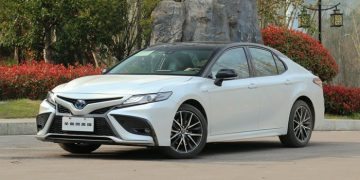Introduction: The Rise of Electric Vehicles and the Automotive Supply Chain
The automotive industry is undergoing a profound transformation as electric vehicles (EVs) shift from being a niche market to the dominant force shaping the future of mobility. This transformation has significant implications for the global automotive supply chain, which has traditionally relied on the production of internal combustion engine (ICE) vehicles. As manufacturers pivot to meet the growing demand for electric vehicles, the entire supply chain—from raw materials to vehicle manufacturing processes—must adapt to new technologies, production methods, and business models.
The global automotive supply chain has been a well-oiled machine, fine-tuned over decades to produce ICE vehicles. However, as the automotive industry faces pressure to reduce carbon emissions, comply with increasingly strict environmental regulations, and respond to changing consumer preferences, the shift to electric vehicles presents both opportunities and challenges. This article will analyze how the rise of electric vehicles is disrupting the global automotive supply chain, examining the impact on raw material sourcing, component manufacturing, vehicle assembly, and logistics.
Raw Materials: A Shift in Demand
One of the most significant ways that electric vehicles are impacting the global automotive supply chain is through a fundamental shift in the demand for raw materials. Traditional ICE vehicles rely heavily on components like the engine, exhaust system, and transmission, which require materials such as steel, aluminum, and copper. However, EVs operate using electric motors and lithium-ion batteries, which demand an entirely different set of materials. The most notable of these are lithium, cobalt, nickel, and rare earth metals.
1. Lithium, Cobalt, and Nickel: The Key to EV Batteries
Lithium-ion batteries are the powerhouses of electric vehicles, and their production relies on key raw materials, including lithium, cobalt, and nickel. These materials are essential for creating the high-performance batteries required for electric vehicles’ long range and fast charging capabilities.
The growing demand for electric vehicles has led to a surge in the demand for these critical materials. According to the International Energy Agency (IEA), the demand for lithium is expected to increase by nearly 40 times by 2040, while demand for cobalt and nickel is also set to rise significantly. This shift in raw material demand is reshaping the global supply chain, particularly in countries where these materials are abundant, such as the Democratic Republic of Congo (cobalt), Australia (lithium), and Indonesia (nickel).
However, the extraction of these materials raises ethical and environmental concerns. For example, cobalt mining has been linked to human rights abuses and environmental degradation. As a result, automakers and battery manufacturers are under increasing pressure to ensure responsible sourcing practices. In response, companies are investing in alternative battery chemistries, such as lithium iron phosphate (LFP) batteries, which reduce the reliance on cobalt.
2. Rare Earth Metals: The Need for Sustainable Sourcing
Electric vehicles also require rare earth metals such as neodymium, dysprosium, and praseodymium, which are essential for manufacturing the magnets used in electric motors. These metals are not only critical to EV production but also face supply constraints due to their concentrated availability in a few countries, particularly China. The dependence on China for rare earth metals is a geopolitical challenge that may disrupt supply chains, especially as countries seek to diversify their sourcing strategies.
Automakers are increasingly focusing on developing more sustainable ways to source rare earth metals, including recycling and improving the efficiency of mining processes. Additionally, some companies are exploring alternative motor technologies that reduce the reliance on these rare earth metals, further reshaping the supply chain.
Component Manufacturing: New Challenges and Opportunities
The transition from traditional internal combustion engines to electric powertrains introduces several new challenges and opportunities in the component manufacturing sector. Electric vehicles are composed of fewer parts than their ICE counterparts, which can simplify assembly but also requires a different approach to component production.
1. Battery Manufacturing: A New Industry Emerges
One of the most significant changes in the component manufacturing process is the rise of battery manufacturing. Unlike ICE vehicles, which rely on external suppliers for engine and transmission components, electric vehicles rely on large, sophisticated battery packs. This has led to the creation of an entirely new industry around battery production. Major automakers such as Tesla, Volkswagen, and General Motors are investing heavily in establishing in-house battery manufacturing capabilities to secure their supply chains and reduce costs.
The scale of investment required to build battery production facilities is staggering. For example, Tesla’s Gigafactory in Nevada, one of the largest battery production plants in the world, requires billions of dollars in capital expenditure. In addition to automakers, a range of technology companies, such as Panasonic and LG Chem, are also playing a crucial role in the development of battery technologies, further expanding the supply chain ecosystem.
2. Electric Powertrain Components: Simplifying the Manufacturing Process
Electric powertrains are significantly simpler than traditional combustion engines. They consist of fewer moving parts, with no need for components like pistons, camshafts, or timing belts. While this simplifies assembly and reduces the number of parts in the vehicle, it also presents challenges for traditional auto suppliers that have built their businesses around the production of ICE components.
Suppliers of engine and transmission parts must pivot to focus on the production of electric motors, inverters, and other essential EV components. This requires substantial investment in new manufacturing capabilities and expertise in electric powertrain technology. Some traditional suppliers have already begun this transformation, while others are struggling to stay relevant in a changing landscape.

Vehicle Assembly: Adapting to EV Manufacturing
Vehicle assembly processes are also being impacted by the shift to electric vehicles. As automakers ramp up EV production, they are adjusting their assembly lines to accommodate the unique requirements of electric vehicles.
1. Redesigning Assembly Lines
Electric vehicles require different assembly techniques compared to traditional vehicles. For instance, battery packs are often installed into the chassis early in the assembly process, and specialized equipment is needed to handle the heavy and delicate batteries. The automation used in ICE vehicle production must be adapted or replaced to meet these new requirements.
Some manufacturers are converting existing plants to produce electric vehicles. For example, Ford has repurposed its Rouge manufacturing complex in Michigan to produce the electric F-150 Lightning pickup truck. Other automakers, like General Motors, are building new plants dedicated solely to electric vehicle production. These new plants are often highly automated, incorporating advanced robotics and AI-driven production techniques to enhance efficiency and precision.
2. Skilled Workforce and New Capabilities
As automakers shift to electric vehicle production, they must invest in retraining their workforce. The assembly of electric vehicles requires new skills, particularly in working with high-voltage systems, battery technology, and electric drivetrains. Automakers are collaborating with educational institutions and technical schools to provide the necessary training to their employees. In some cases, companies are even offering incentives to workers who complete retraining programs.
Logistics and Supply Chain Management: Ensuring Smooth Operations
The logistics of sourcing, manufacturing, and distributing electric vehicles are becoming increasingly complex. The raw materials for EV batteries are concentrated in certain regions, such as Africa and Australia, while final assembly and vehicle production take place in different parts of the world. This creates new challenges in global supply chain management, particularly as companies strive to ensure timely delivery of critical components.
1. The Need for Localized Production and Sourcing
One of the key trends emerging from the electric vehicle revolution is the push for more localized production and sourcing of materials. Automakers are seeking to reduce their reliance on global supply chains that may be disrupted by geopolitical tensions, natural disasters, or trade restrictions. By localizing production of key components like batteries and electric motors, automakers can reduce costs, improve delivery times, and mitigate the risk of supply chain disruptions.
2. Sustainability in Logistics
Sustainability is a growing concern across the automotive supply chain, and the logistics sector is no exception. As automakers look to reduce their carbon footprints, they are increasingly turning to electric and hybrid trucks for transporting parts and vehicles. Furthermore, optimizing transportation routes, reducing packaging waste, and improving inventory management are critical steps in ensuring that the logistics of electric vehicle production align with the broader goals of sustainability.
The Future of the Automotive Supply Chain: A Paradigm Shift
The shift towards electric vehicles is not just a technological change; it is a paradigm shift that is reshaping the global automotive supply chain. Automakers are no longer just car manufacturers; they are becoming energy and technology companies, developing expertise in battery production, powertrains, and software integration. This transformation will have profound implications not only for the companies that produce vehicles but also for the entire ecosystem of suppliers, manufacturers, and logistics providers that support the automotive industry.
The impact of electric vehicles on the global supply chain is undeniable. From raw material sourcing to the production of critical components, vehicle assembly, and logistics, the automotive supply chain is being reshaped by the need to support a new era of electric mobility. While challenges remain, the transition to electric vehicles also presents enormous opportunities for innovation, sustainability, and efficiency.
As the world moves towards a more electrified future, the automotive supply chain will continue to evolve, driven by the demand for cleaner, more sustainable transportation solutions. For companies that embrace this change, the electric vehicle revolution presents an exciting opportunity to lead the way in a new era of mobility.











































